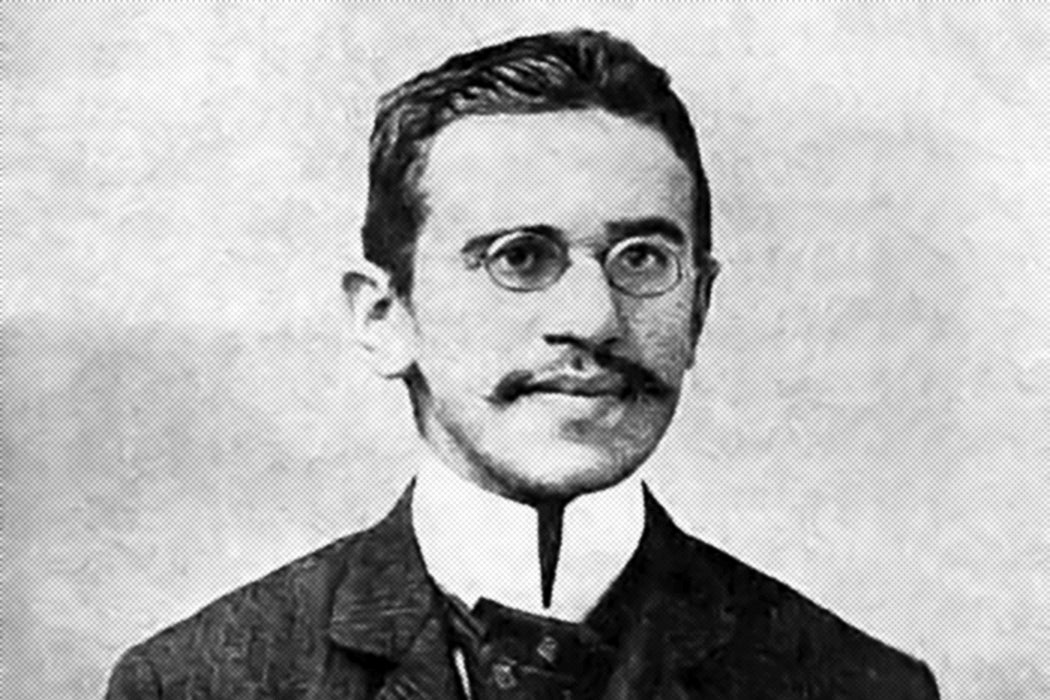There is no place to start with Otto Weininger other than his death. A recently graduated Viennese philosophy student, Weininger published an expanded version of his thesis under the title Sex and Character to very little fanfare. Four months later, he rented a room in the house where Beethoven died. He had been deeply depressed, on and off, ever since he had received his doctorate. He wrote a couple letters to his family and then shot himself, dying in the hospital soon afterward. It was early October 1903, and he was 23.
Though doing so today would be in bad taste, Viennese society luridly discussed the macabre, sensational symbolism of Weininger’s death. By dying in Beethoven’s house, Weininger allied himself with the composer seen as the second or third greatest modern German (after Wagner and maybe Goethe). Weininger was seen as a tortured genius with a truth too powerful for the human mind and heart to bear. And so, to understand that so-called truth, droves of Austrians picked up copies of Sex and Character.
Get Our Newsletter
The contents of Sex and Character are, for a modern reader, almost indecipherable. The only recognizable elements are the book’s idiosyncratic but virulent strains of misogyny, anti-Semitism, and racism, lodged in a slurry of neo-Kantian alchemy and pseudo-mathematical jargon. It is hard to imagine what made the book a fin-de-siècle sensation, much less an influence on thinkers as varied as Ludwig Wittgenstein, the composers Alban Berg and Arnold Schoenberg, the writer August Strindberg, and even James Joyce.
For one thing, trying to read Sex and Character in English is a difficult proposition. For a hundred years or so, the only translation was, as Wittgenstein described it, “beastly.” It contains innumerable errors, even making positive statements negative ones and vice versa. It contradicts its own content, style, and arguments with the vilest, most slovenly sort of bigotry and invented truisms. The state-of-the-art translation corrects some of these errors and reintroduces the 135 pages of endnotes and references, but it is expensive and extremely academic.
As the Viennese philosopher and historian Allan Janik put it in a review of the new translation from 2006, when reading the old edition, “one has the sense of being confronted with the work of a madman, who spins thoughts off the top of his head in a way that can only be described as absurd, so absurd that their very implausibility and contrariness have a way of making it [an object of fascination].” But even with all of these errors corrected, Janik makes it clear that “there is enough in Weininger’s original to encourage that impression.” The book remains a hodgepodge of all sorts of bigotries unscientifically thrown together and presented as the result of incredible introspection. Even with all its ideas clearly laid out, Sex and Character’s popularity is still befuddling. How could a self-proclaimed progressive society like Vienna latch on to such hateful rants?
To understand how Weininger’s words connected with his audience so readily, it is best to understand fin-de-siècle Vienna’s (mostly bigoted) anxieties and how Weininger’s solutions to those anxieties are themselves symptomatic of the larger issues at play. As the historian and classicist Chandak Sengoopta put it in his article “The Unknown Weininger:”
[Sex and Character] is essentially incomprehensible without some appreciation of the contexts as different as Viennese traditions of cultural criticism, fin-de-siècle feminism, Ernst Mach’s theories of the self, neo-Kantian philosophy, and the racial ideas of Richard Wagner. He’s a photographic negative of his time, revealing its hidden, hateful structure.
To begin with the most obvious aspect of Weininger’s philosophy, his prodigious hatred of women, it is clearly a reaction to the inroads made by his feminist contemporaries, an expression of the male anxiety that their demand for rights created. If being a citizen required intellect and reason and women could attain those things, what gave men the right to dominate women (and society in general)? Rather than interrogate the necessity of the status quo, men doubled down in their denigration of women, with calls for gender essentialism rooted in social Darwinism.
The intellectual Karl Kraus, who would later defend Weininger from accusations of plagiarism, argued that women’s “liberty would detract from woman’s ‘natural’ role of providing the creative spark for men and keeping a cultural gender balance,” writes the German literary scholar Susan C. Anderson in “Otto Weininger’s Masculine Utopia.” Feminists were described as “half-women” by eminences like the future Weininger fan August Strindberg. As if to fight this assertion, central European feminism tried to use this gender essentialism against itself and stressed, as Sengoopta puts it, “the social, cultural, political, and metaphorical importance of motherhood.” Perhaps because men in Viennese society didn’t entirely understand the intense domestic labor of motherhood, this point, however stressed it was, did not do much to convince anti-feminists.
For Weininger, it was not enough to denigrate women politically for the sake of male comfort. He felt he must establish a have-your-cake-and-eat-it-too kind of metaphysics where female is not a gender but a cosmic energy, one that just happens to embody all the evil aspects of the world and from which real living women cannot fully escape. Those consumed by this female force have no higher intellect and are entirely sexually motivated, cunning, and materialistic. As he puts it, “woman is neither high-minded nor low-minded, strong-minded nor weak-minded. She is opposite all these. Mind cannot be predicated of her at all; she is mindless.” Because of this lack of higher function, women delight in bureaucratic matchmaking above all else, even the craven sexuality Weininger has hoisted upon them. In short, they are not “complete, autonomous individuals in an ontological sense” (Sengoopta). Nevertheless, in his tortured way Weininger believes that Sex and Character “may be considered as the greatest honor ever paid to women” because he seeks to understand them as no one ever has before and without moral judgment. “It is impossible to think highly of women, but it does not follow that we are to despise them forever.”
These aspects are absolutely essential to the feminine energy, Weininger claims. Sure, women can have varying percentages of male and female in them, but they’ll never have more than 50 percent man in their essence. This leads to Weininger’s pseudo-progressive position that the greatest women are lesbians and “mannish” women because they contain the largest percentage of masculine essence possible for a woman. Therefore, to emancipate even the most masculine women would be to liberate them for the sake of the half of their being that cries out for liberation, which is therefore (somehow) unjust to the other, unthinking, feminine part. As Weininger explains it, the universe just happened to shake out that way. He doesn’t want to hate women, but this is just how existence revealed itself to him through his intense study of psychology, and so he must hate “what women represent,” even though he decries the lazy arguments that justify gender essentialism with sexual dimorphism in the first part of his book.
Weininger’s work would be much less interesting—but just as fraught—if he stopped there. Weininger has a critique of the burdened, sensational definition of male identity in his era as well, though he does not condemn men as he does women. After all, it was the crisis in masculinity, brought on by the idea of female suffrage, that Weininger would have felt personally. As Anderson writes, “As masculinity grew more problematic in the late nineteenth century, Weininger’s male contemporaries turned to sometimes drastic means to prove their manhood,” with dueling as its aesthetic pinnacle. Any indication of effeminacy was to be avoided.
Weininger was barred from dueling, soliciting sex, and other male maturity rites because he grew up Jewish, and therefore he was never allowed to “prove” his manhood “which would also disprove the stereotypes of [Jews] as cowardly and weak.” He incorporated this alienation into his moral theory, disavowing both contemporary effeminacy and masculinity as sex-obsessed, unserious, and profane. Instead he promotes a celibate, introverted hermetic ideal of “New Man.”
Anderson describes Weininger’s “New Man” as containing the classic Germanic virtues seen in Wagner’s operas. In exchange for this ethical mastery, the New Man would “be rewarded with inner harmony… the erotics of art [replacing] the function of sexual coitus.” As the population dwindles because sex is had by only the lowest of the remaining men, “art is the replacement for children, who, in [Weininger’s] thinking, aren’t ‘real’ children, just bad copies of the bad woman who carried them.” Though his body will die, the New Man concerns himself only with the immortal neo-Platonic forms of beauty and order and thereby finds peace. Weininger’s ideal masculinity is indeed stranger than anything he might have seen in Wagner, Kant, or mainstream society, but its appeal was that it was fresher and more apparently solid (if doomed) than any other broken ideology available at the time.
Though it allowed him to occupy the outsider perspective that he came to exalt, Judaism itself was a confounding factor for Weininger’s masculinity, and he excoriated it accordingly. Even more than the hypothetical totally female woman, the Jew is the antipodal opponent of the New Man because he is a Grenzverwischer, a destroyer of the very boundaries that create Weininger’s neo-Kantian categories. For Weininger, the Jew naturally incorporates all the evil, materialistic feminine qualities that are unnatural to the Aryan man. Of course, the Jew in Weininger’s philosophy—as in most of European history—is seen as a dissembler: an obscurer and cheat taken to metaphysical heights. As Weininger did with women, he stresses that “the Jew” is an idealized enemy, rather than any particular Jew or Jews. In fact, he says, most anti-Semites are partially Jewish in their mindset, and that is why they hate real Jews so much!
Again as in the case of women, all the qualities he sees in “the Jew” are found, in his mind, primarily in Jewish people. Even Weininger’s favorite Jew, the philosopher Baruch Spinoza, could never escape his depravity because of his inborn predilection toward philosophical materialism. He also states that the Jew who has converted to Christianity has successfully freed himself of the evils of his religion and people. Conveniently, Weininger had converted to Protestantism as he graduated from school, so he was in the metaphysical clear. Weininger at once sought to justify his own closed-off, sex-averse personality and to vilify those things about himself that he hated—his effeminacy, his Jewishness—and could not control, as if he needed to exorcise himself of them.
I do not want to provide an overbearing, ersatz psychological assessment of Weininger and his hang-ups, but it is clear that he needed a moral universe where he could be on top in order to justify his existence. As Anderson writes:
Weininger has two types of virtuous (male) humans: the saint who achieves truth through meditation and the genius who gains it through observation. Weininger attempted to be both and saw himself struggle constantly against internal chaos.
He was the best man that could exist in his philosophy, or he desperately wanted to believe that he was.
Fin-de-siècle Austrian society had come under the influence of Herbert Spencer and social Darwinism like the rest of western Europe, but here a more philosophical perspective took hold. The physicist Ernst Mach’s foray into psychology—the idea that people are merely sums of stimuli and reflexes—annihilated the metaphysical self, reducing the soul to a series of sensations. Though most Austrians, including author Robert Musil and even Weininger for a time, believed and built on the idea, no one much liked it. It was a philosophical dead end that condemned humanity to depravity. Weininger’s philosophy allowed for the immutable forms and categories—Beauty, Reason, Man, Meaning—to return to people’s lives. Add in the anti-Semitism championed by Vienna mayor Karl Lueger in the 1880s, the failure of Jewish attempts at assimilation, and the previously mentioned anti-feminism, and you have a society waiting for a reactionary.
Weininger’s reception makes sense even among the intellectual elite. As the scholar Steven Beller discusses in “How Modern was Viennese Modernism?” the turn of the century was a censorious time in Austria. Even University of Vienna professors fought against the installation of “pornographic” paintings by Gustav Klimt. In fact, Friedrich Jodl, the leader of this regressive group, was Weininger’s university advisor. In their minds, the people’s identification with being Machian bundles caused them to exhibit these animalistic thoughts and activities. The Austrian academy demanded a return to ethics—to “family values.” To which ethics or family values, no one could quite decide. And in slips Weininger.
Even those who didn’t take his philosophy seriously found useful types in it. The extremeness of Weininger’s opinions and the force with which he presented them caught the eye of many of the great modernists. The literary scholar Ralph Robert Joly looks at how Weininger’s description of Jews influenced James Joyce, who would have read Sex and Character in the original German—specifically, his characterization of Leopold Bloom in Ulysses. Joly contends that, although Bloom has many of the sexual, materialistic, feminine traits that Weininger ascribes to Jewish men, Joyce couldn’t have been a true believer, since Bloom is a fully human character that “[confronts] the bigots of his time.”
Nevertheless, he concedes that Joyce “found Weininger a confirming source for attitudes he had previously formed and a stimulus for new ones to be shaped in effecting theme.” Similar assessments could be made of composer Alban Berg’s depiction of Frank Wedekind’s femme fatale in Lulu, the aesthetic purity of Arnold Schoenberg’ early atonality, and the attempts at analytic completeness found in Wittgenstein’s earliest work, Tractatus Logico-Philosophicus (which he later disowned, while holding on to his fascination with Weininger). These intellectuals tried to pick wheat from the racist, misogynist chaff of Sex and Character and found something that could propel their art—along with some of their subtler prejudices.
But no matter the art: Weininger’s most enduring and truest legacy is as an intellectual inspiration for what would later become the Nazi Party. Dietrich Eckart based his famous adaptation of Peer Gynt on Weininger’s idealized Jew, seen as a troll. Eckart’s success allowed him to provide social entry to a young Adolf Hitler, who supposedly spoke of Weininger in passing as the only decent Jew he knew of. Though it was politically advantageous, Weininger’s work was later banned by the Nazis, because he was nonetheless a Jew by birth.
Weininger’s work was a prime starting point for fascists because it seeks to justify ethics, politics, and aesthetics in metaphysics. It first presents its bigotry as a benign, ancillary aspect of its grand perspective—one philosophy among many vying for currency—and then, once in power, obviates any disagreement; all other opinions and people are inferior and therefore incapable of presenting valuable arguments. At one point Weininger does this explicitly with the aspects of Schopenhauer’s thinking that he doesn’t like: The old philosopher was destined to have an unrealistically gloomy outlook because of the shape of his face. This kind of blithe disregard for the validity and intellect of other people is Weininger’s legacy, a hatred that lay under the bourgeois surface of the rest of European society and that would erupt in the ensuing decades.







